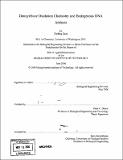| dc.contributor.advisor | Peter C. Dedon. | en_US |
| dc.contributor.author | Zhou, Xinfeng | en_US |
| dc.contributor.other | Massachusetts Institute of Technology. Biological Engineering Division. | en_US |
| dc.date.accessioned | 2007-07-18T13:14:42Z | |
| dc.date.available | 2007-07-18T13:14:42Z | |
| dc.date.copyright | 2006 | en_US |
| dc.date.issued | 2006 | en_US |
| dc.identifier.uri | http://hdl.handle.net/1721.1/37954 | |
| dc.description | Thesis (Ph. D.)--Massachusetts Institute of Technology, Biological Engineering Division, 2006. | en_US |
| dc.description | Includes bibliographical references. | en_US |
| dc.description.abstract | Endogenous and exogenous oxidants react with cellular macromolecules to generate a variety of electrophiles that react with DNA produce cytotoxic and mutagenic adducts. One source of such electrophiles is deoxyribose in DNA itself. Oxidation of each position in deoxyribose generates a unique spectrum of products, many of which are highly reactive with DNA bases and lead to formation of adducts. The objective of this thesis was to clarify the chemistry of deoxyribose oxidation, with a focus on C4'-oxidation that gives rise to 3'- phosphoglycolate residues on the DNA backbone and releases base propenal or malondialdehyde, and to investigate the role of base propenals in the formation of an important endogenous DNA adduct, MI dG. First, an index of total deoxyribose oxidation was developed, one that provides a means to compare different oxidizing agents. This method exploits the reaction of aldehyde- and ketone-containing deoxyribose oxidation products with 14C-methoxyamine to form stable oxime derivatives that are quantified by accelerator mass spectrometry. Sensitive GC/MS methods were developed to quantify 3'-phosphoglycolate residues from deoxyribose C4'-oxidation and HPLC/post-column derivatization methods were developed to quantify the corresponding base propenal or malondialdehyde. | en_US |
| dc.description.abstract | (cont.) Combined with the quantification of total deoxyribose oxidation and the alternative product of C4'-oxidation, the 4'-ketoaldehyde abasic site, under the same conditions, these results offered direct insights into the partitioning of C4'-oxidation and the chemical mechanisms of deoxyribose oxidation in DNA. With a foundation of deoxyribose oxidation chemistry and analytical methods, the in vitro DNA oxidative damage induced by y-irradiation, Fe2+/EDTA, bleomycin and peroxynitrite was explored. The results revealed that malondialdehyde was neither sufficient nor necessary for the formation of MldG, while base propenal was effective in generating MldG. These observations were extended to an E. coli cell model in which the membrane content of polyunsaturated fatty acids was controlled. The results revealed that lipid peroxidation caused by y-irradiation was insufficient to produce MldG in cells and the level of MldG adducts was inversely correlated with the quantity of membrane polyunsaturated fatty acids when cells were treated with peroxynitrite. Finally, M1dG showed a moderate (-50%) increase in tissues from a mouse model of inflammation, while etheno-adducts induced by lipid peroxidation increased -3- fold. These results are again consistent with lipid peroxidation as a minor source of MldG. | en_US |
| dc.description.statementofresponsibility | by Xinfeng Zhou. | en_US |
| dc.format.extent | 220 p. | en_US |
| dc.language.iso | eng | en_US |
| dc.publisher | Massachusetts Institute of Technology | en_US |
| dc.rights | MIT theses are protected by copyright. They may be viewed, downloaded, or printed from this source but further reproduction or distribution in any format is prohibited without written permission. | en_US |
| dc.rights.uri | http://dspace.mit.edu/handle/1721.1/7582 | |
| dc.subject | Biological Engineering Division. | en_US |
| dc.title | Deoxyribose oxidation chemistry and endogenous DNA adducts | en_US |
| dc.type | Thesis | en_US |
| dc.description.degree | Ph.D. | en_US |
| dc.contributor.department | Massachusetts Institute of Technology. Department of Biological Engineering | |
| dc.identifier.oclc | 144608228 | en_US |
